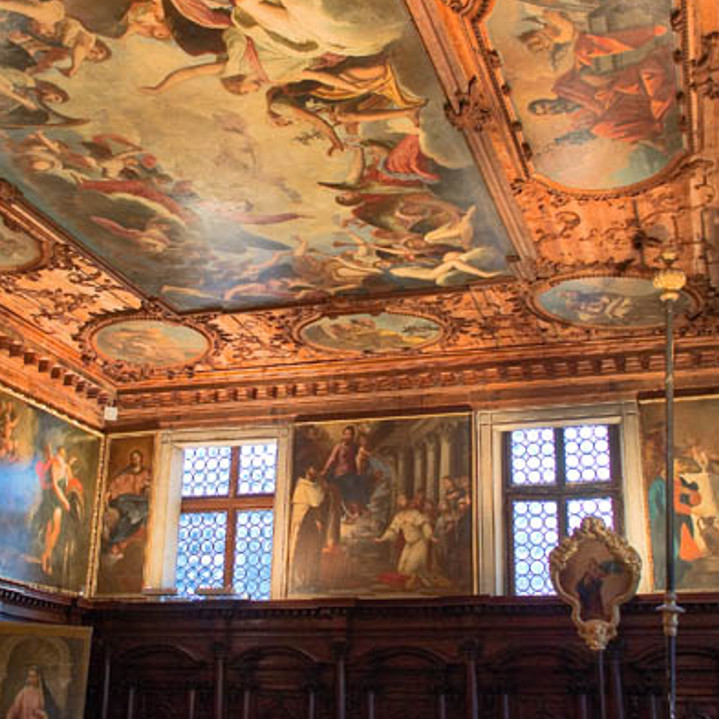You are here
Ghetto Venezia

GHETTO OF VENICE![]()
THE GHETTO OF VENICE FOR ALL VISITORS WITH A FREE APP IN ITALIAN, ENGLISH, FRENCH, GERMAN, SPANISH
BOOKABLE TOURS THROUGH VENEZIA UNICA:
EVERY DAY (closed on Saturdays). Special CLOSURES on Jewish holidays
- Visit with App to the Ghetto of Venice [timetable]
(a visit to 2 synagogues of the Ghetto of Venice is included)
Visit the Jewish Ghetto of Venice in full autonomy using the multilingual App that will guide you through the history, the historic buildings, including no less than five Synagogues, the study buildings, the so-called Midrashim and the ancient bakery.
In addition, depending on the day chosen at the time of purchase, you will be able to visit the following Synagogues:
[by presenting the barcode included in the voucher at the Ghetto ticket office].
- Sunday, Monday, Tuesday, Wednesday and Thursday: visits include the Levantine Synagogue and the Spanish Synagogue;
- Friday: visits include the Italian Synagogue and the Spanish Synagogue.
PLEASE NOTE: At the time of booking, it is compulsory to choose the date of the visit according to the availability of the calendar.
However, you are free to choose any of the proposed dates for your visit.
IMPORTANT: Enter the App activation-code only on the day of the visit.
€ 14,00 FULL (includes €2.00 booking fee)
€ 12,00 REDUCED 6 -26 years - journalists (includes €2.00 booking fee)
€ 9,00 REDUCED RESIDENTS (includes €2.00 booking fee)
It is possible to visit the Ghetto of Venice by choosing your own itinerary among those proposed in the APP
EVERY DAY (closed on Saturdays). Special CLOSURES on Jewish holidays

CAMPO DI GHETTO
In Venice, all open spaces and squares surrounded by buildings are called fields, and in fact these areas were used to grow vegetables as in the countryside. The ghetto camp is surrounded by the Jewish retirement home, some kosher places, the German and Italian synagogues, and tall buildings with private apartments. In the field there are three fifteenth-century wells, two of pink Verona marble and one of Istrian stone. On the façade of the old people's home there are some bronze bas-reliefs, the work of the Lithuanian sculptor Arbit Blatas, in memory of the Shoah: two were installed in 1980 and a third, entitled "The Last Train", was placed in 1993, on the fiftieth anniversary of the deportation of the Jews from the Venice ghetto. Venice had become the centre of trade between the East and the West, and the Jews became merchants of cloth and resellers of second-hand clothes and objects, increasingly known above all for their established activity as "free rate" money lenders since the 14th century. They were educated people, unlike the Christians, who were mostly illiterate at the time.


The Levantine Synagogue was built in the Old Ghetto in the second half of the XVI century by Jews coming from the East, mostly merchants and wayfarers. La Serenissima had granted them the right to reside in the city and to build a holy building apart from the others and, in some manner, privileged. Tradition sets the date of foundation of the Levantine Synagogue in 1538, but it most likely dates to the following decade.
The merchants wanted their temple to stand out also for size and visibility, so that it could show the wealth of their Community, as well as reflect the eastern taste for grandiosity. It is, in fact, the only building that compared to the generically popular typology of ghetto constructions, boasts a prominent external architecture. One façade of the Levantine Synagogue is oriented towards the Campiello delle Scuole, while the other looks onto Calle di Ghetto Vecchio and is characterised by the presence, on the second floor and between the tall windows with semi-circular arch, of a lovely protruding aedicule, known as the “liagò”, which recurs in Venetian architecture and that we also find in other Scholas.
To date, being the only one equipped with a heating system, this Synagogue is used by the Venetian community in the winter period.


The great synagogue of the Western Nation was the last of the synagogues of Venice to be founded in the Old Ghetto. It is the main Synagogue of the Venetian Jewish Community and it is used for most of the year, both on Saturday and for the main festivities.
The date of its foundation is not known with certainty, but it seems its official opening dates to 1584 circa. Originally, the Spanish Synagogue was smaller than it currently is, though it also had a women’s gallery.
Around the year 1660, the Western Community began to purchase several buildings adjoining their temple so that they could enlarge it, effectively becoming the city’s largest.
The external elevation of the tall building is simple and characterised by four large arched windows that rise over a marble plaque dedicated to the Jewish victims of the death camps.


The Schola Italiana can be recognised in the square of Ghetto Nuovo for the five large windows surmounted by a crest with the writing, “Holy Italian Community 1575” and for the cupola that towers over the Bimah or Tevà, which is to say the pulpit. On the rose façade you will note a little projecting temple on the first floor, which does not belong to the Synagogue and, on the ground floor, the little loggia that survives the arcaded structure typical of the Ghetto and common to most of northern Italy. The passageways that pass beneath buildings and are known as sottoporteghi indeed afforded shelter from bad weather to trade and negotiations.
Born as a readjustment to a pre-existing dwelling, the Synagogue was initially located on the first floor of the building and then, with time, transferred to the top floor, but in any event maintaining access via the original entrance. The Schole (Synagogues) were usually inserted and concealed among the houses so as not “to cause scandal to Christianity”, as prescribed by the Condotte of the Most Serene Republic.
Today, the ground floor, beneath the Schola Italiana, hosts a hotel, and it is fascinating to imagine falling asleep knowing that you have a Synagogue over your head.
The current look of the interior of the Italian Synagogue dates back to the last radical restoration that gave a neoclassical harmony to the entire structure. It is open to the public on Friday mornings or booking a private guided visit.
downloadable APP on your SMARTPHONE
via free Wi-Fi connection at the ticket office




|
Visit with App to the Ghetto of Venice
Good to Know: |
|||||||||







